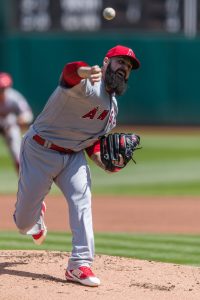The Blue Jays and their fans were surely excited to see a potential wave of young talent reach the Majors, with Bo Bichette, Vladimir Guerrero Jr. and Cavan Biggio all debuting in 2019, but the team’s pitching proved to be a disaster. Toronto starters posted a combined 5.25 ERA, and that number includes Marcus Stroman’s pre-trade contributions. Cut out his 124 2/3 innings of 2.96 ERA ball, and non-Stroman Blue Jays starters recorded a 5.74 ERA.
As such, it was hardly a surprise to hear general manager Ross Atkins declare that his organization plans to “look for pitching in every possible way” this offseason when meeting with the media yesterday (Twitter link via Ben Nicholson-Smith of Sportsnet). That’s probably a bit of hyperbole, as no one’s expecting the Jays to be prime suitors for Gerrit Cole or Madison Bumgarner. However, Atkins also suggested that simply acquiring filler won’t be good enough. Rather, the the Jays need arms they can “count on” to “contribute in significant ways.”
Currently, the Blue Jays’ rotation is virtually bereft of certainty. Trent Thornton led Toronto starters with 139 1/3 innings. But while he showed an ability to miss bats and had some positive stretches, the collective results (5.04 ERA, 4.80 FIP) were lackluster. No other pitcher currently on the Jays’ roster even tossed 70 innings as a starter. Right-hander Jacob Waguespack managed a 4.13 ERA with lesser peripherals in 65 1/3 innings. Injuries wiped out Ryan Borucki’s season. Veteran Matt Shoemaker gave the Jays 28 2/3 innings with a 1.57 ERA (3.95 FIP) before suffering an ACL tear early in the season. Lefty Anthony Kay, acquired in the Stroman trade, should get a chance to log a high volume of innings next year.
The Blue Jays, notably, still have Shoemaker under club control. He signed last winter after being non-tendered by the Angels but only had four-plus years of service time. He’s still shy of six years of service, meaning the Blue Jays can control him via arbitration. Atkins didn’t tip his hand with regard to Shoemaker’s status, though Nicholson-Smith suggests that Shoemaker is open to a multi-year deal (Twitter link). Such an arrangement, presumably, would buy out Shoemaker’s final arbitration season and give Toronto an additional year of relatively cheap control. Simply retaining Shoemaker via arbitration wouldn’t be an onerous financial commitment, as his 2019 salary checked in at just $3.5MM.
Realistically, though, the Blue Jays shouldn’t fret much over any levels of spending. Toronto has only $29MM in guaranteed money on the books in 2020, and their arbitration class only features one player in line for a notable raise: closer Ken Giles, who’ll be an offseason trade candidate anyway. Giles is due a raise on this season’s $6.3MM salary. Beyond him, Shoemaker, Devon Travis ($1.925MM in 2019), Ryan Tepera ($1.525MM), Brandon Drury ($1.3MM), Ryan Dull ($860K), Derek Law (pre-arb) and Luke Maile (pre-arb) are the only players who are in line for raises. Travis, Dull and Maile are non-tender candidates.
To that end, Atkins indicated that the Jays plan to spend more aggressively this winter than in the past two offseasons, stating that the “overall outlay will be more significant” than last year while voicing a willingness to add salary in trades (Twitter link via Nicholson-Smith). Even looking past the market’s elite options, there’ll be useful starters for the Blue Jays to pursue. Jake Odorizzi, Dallas Keuchel and Tanner Roark are among the many second-tier options in free agency, and the trade market should offer additional names. Toronto isn’t lacking in outfield options that could be made available to other teams, with Anthony Alford, Derek Fisher, Teoscar Hernandez, Jonathan Davis and Billy McKinney all on the 40-man roster (in addition to the well-compensated Randal Grichuk and breakout left fielder Lourdes Gurriel Jr.). None of that bunch is going to headline a deal for a marquee name, of course, but any could be a piece in a theoretical deal.
Looking to the team’s collection of position players, that glut of outfielders and the aforementioned emergence of several key infielders should give the team a promising (but still raw) lineup. Bichette and Biggio will comprise the team’s middle-infield tandem next season, and Atkins emphasized that the Jays are committed to Guerrero at third base, though they want him to improve his conditioning in the offseason. Danny Jansen showed pop and elite defensive skills behind the plate, even if his overall .207/.279/.360 batting line was obviously weak. He had a fairly productive three-month stretch from June to August (.243/.310/.459, 10 homers in 203 plate appearances), so there’s some hope for better days ahead.
A reunion with Justin Smoak at first base isn’t out of the question, Nicholson-Smith tweets, but the Jays have Rowdy Tellez as an option there and will likely look at more defensively versatile options in free agency. “It’d be nice to consider alternatives that are more flexible, can play other positions as well,” Atkins said. Speculatively speaking, Todd Frazier, Neil Walker, Brock Holt and Jedd Gyorko are among the many infield options on this year’s market who have experience at multiple positions, and as with the pitching market, there will be alternatives available via trade.
It should be noted that a promise of increased offseason spending doesn’t necessarily mean an increase in the team’s Major League payroll. Toronto opened the 2019 season at $114.5MM, and given the numerous pre-arbitration players occupying key roster spots, upping the actual payroll would mean taking on perhaps more than $60MM in 2020 salary alone. That may technically be plausible based on previous payroll levels — the Jays peaked at $163MM in 2017 — but team president Mark Shapiro cautioned against being the team that “wins the offseason” only to fall shy of postseason play. A more aggressive winter seems certain, but the Jays probably won’t be going for broke just yet.
